#I have a month to make ref sheets and give them pages :3
Explore tagged Tumblr posts
Text
chat what do we think about artfight 2025 :3
#i wanna do it…#she posting#artfight#artfight 2025#OCs#miscellanaverse#I have a month to make ref sheets and give them pages :3#art fight#art fight 2025
14 notes
·
View notes
Text
EVIL DOUBLED (FNAF AU)
This was sorta just for fun while I do school and what not! AU idea where Henry and William are BOTH evil and work together!

This screenshot redraw is what started it all!
Thats William’s remnant in there btw hes sorta michael-mode rn but theyre gonna put it back in him once theyre done posing all cool- He JUST survived being springlocked for the first time
Now lets get into ref sheets! (There will be a page break after and all lore/info about the au will be down there!)
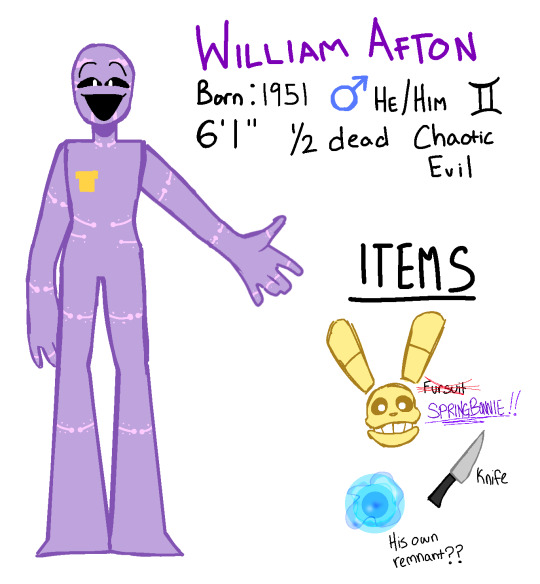
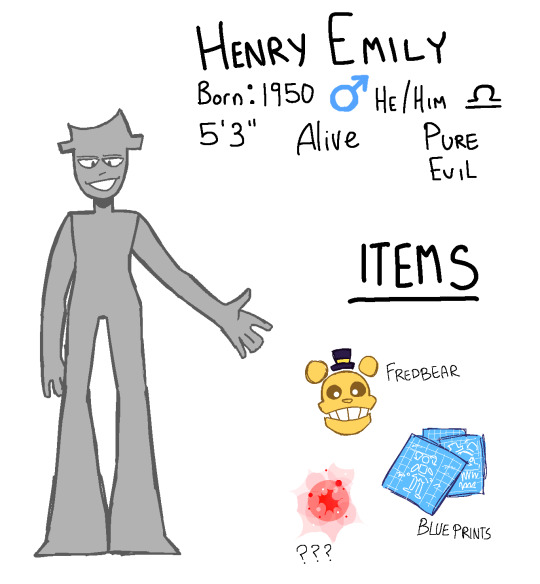

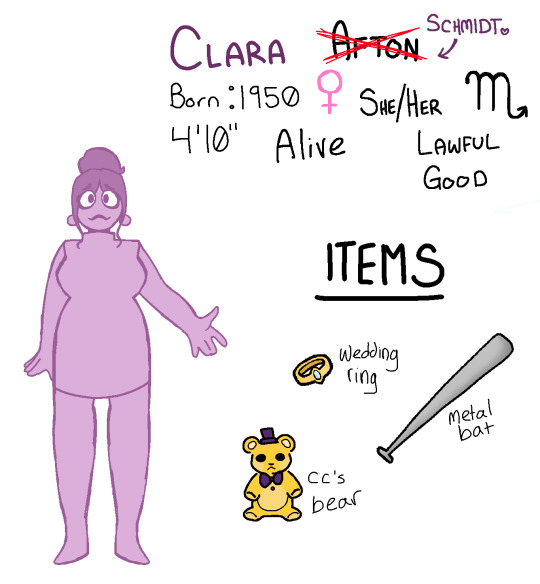
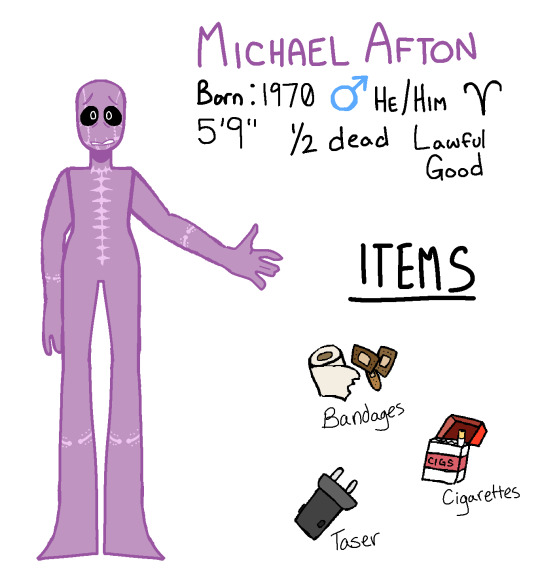
OK SO!!! The au def is similar to canon a lot and so
The MAJOR plot changes would be:
-Will and Henry BOTH get springlocked
•this fucks over Cassidy and CC being in Fredbear already though, so to solve this issue Cassidy, CC, and Charlie, will all share the puppet.
-Henry now occupies Fredbear instead, and so we now get Springtrap and Beartrap.
-William does NOT have time for the wife murder subplot, so Mrs. Afton (Clara) gets to live fully, she replaces Henry now. Diving into the duo’s blueprints and creations so she can one day stop them. She works with Michael.
-Henry’s wife is ALIVE! Her name is Dorothy and she returns to Hurricane after receiving a call from Clara. She also becomes a Henry replacement.
-Because of Clara and Dorothy’s new role, the pizza sim speach is now WAY more female rage style. This is the wrath of scorn mothers. UCN will be 100000x worse.
-Oh and no disks- William tries to push them but Henry 100% shuts them down and thinks theyre dumb.
-So fnaf 4 is JUST cc’s dying nightmare and eventually michael DOES get gas drugged and sees the nightmares but thats NOT fnaf 4 thats just a bad trip!
-Also, with William not being able to run rampant with random robot murder (Henry keeps him in check) we DO see the base finale in pizza sim.
-When we get into help wanted, ar, security breach, and ruin that follows a SECOND plot line fully separate from the first, where we see a surge of copy-cat killers (this is where we get characters like Vanessa and Jeremy, and Gregory will also be a part of this, being the main villain in Ruin now bc the Mimic was never made)
-William and Henry are a good team here, mutual bond and gain.
-William is far more explosive and emotional, his drive coming from CC’s death sorta setting off a domino effect of underlying mental health issues. He just kinda loses it. This team gives him the delusion that he may one day see CC again.
-Henry is in it bc hes a capitalist. And hey, turns out unlike electricity, theres NO remnant bill. So making all his robots run on human souls is cheaper! He doesnt really care much about charlie after like 3 months of her being dead. He knows it was William. He doesn’t care.
GENETICS?!
yeah theres genetics-
not gonna draw out the punnet squares but the colors of the characters ARE genetic traits!
Henry’s grey is a rare recessive trait. So it was EXTREMELY unlikely to pass onto Charlie. Which it didnt.
Dorothy’s green is a common dominant trait, Charlie ended up green like her!
William and Clara are BOTH purples. William is a more blue-purple, Clara is a more red-purple (commonly mistaken for pink!)
Both purples are dominant traits, so it is a 50/50 with their offspring to produce a blue-purple or red-purple.
Michael and Elizabeth both ended up red-purple!
Michael is VERY red-purple, very much almost mistaken for pink like his mom.
Elizabeth is closer to true purple than michael, but still red-purple!
CC is the only afton child to end up blue-purple! If he hadnt died he wouldve ended up being Williams favorite child!
#fnaf#fnaf art#fnaf au#evil doubled au#evil doubled#art#digital art#au#ramu au#alternate universe#william afton#michael dont leave me here#michael afton#henry emily#fnaf characters#modified sprite forms#purple guy#silly#ok bye bye
43 notes
·
View notes
Text
My TTRPG Lexicon
A list of common tabletop role-playing game terms:
Arc: Adventures, chapters, seasons, story arcs, all terms to describe different sections of the overall campaign. Things like “Training Arc”, “The Harbor Adventure”, “Blood War”. Whatever you decided to use to describe a specific section of your campaign. These would only last a few sessions of a larger campaign.
Campaign: Speaking of campaigns, these are a series of adventures and sessions that cover a multi-arc story. These can last for a few months or even multiple years. Whether you start the campaign with a designated endpoint in mind or just want to play until the game fizzles is fun either way. Most of my games have just fizzled out due to numerous external factors but I still had a great time.
Character Sheet: This is the paper or packet of papers that players use to track their character’s information. Some ttrpgs have multiple pages of information you need to keep track of. Some have only one page. Some don’t even have character sheets; you just write the basic information in an index card or scrap paper.
Core Rules: Core rules are basic or generic game mechanics that developers can build a game around. Some examples of Core Systems are D20, GURPS, and Powered by the Apocalypse. Most of the time a game gets made and its system is so unique or interesting that it gets replicated into other games. For example, Apocalypse World created the Powered by the Apocalypse or PBTA system. Whereas Generic Universal Role Playing System or GURPS was built from the ground up to be a core system for games and settings to be built onto it.
Crits: Most systems have some kind of superior success when you roll a specific number on the dice. Usually the highest or lowest numbers on one of the die. Crits either give you a special bonus or penalty based on the rules of the game. Some even let the player take control of the narrative in a limited way. Not all games use crits but the ones that do make it special.
Dice: One of the most common tools in TTRPGs. Dice can have any number of sides, the most common being six sided dice, sometimes called monopoly or yahtzee dice. These are abbreviated as d6. If you see a number followed by a dice number that tells you how many dice of that type you need. For example 3d6 says you need to roll 3 six sided dice. Dice come in numerous shapes and sizes. A standard 7 piece set of polyhedral dice will include a d4, d6, d8, two d10, d12, and d20. Goodman games dice sets will also include D3 (which is just a d6), D5, D7, D14, D16, D24, and D30. There’s also a d100 which is the size of a golf ball and impossible to read. Most of the time if you need to roll a d100 or d% you roll two d10s with one designated as the 10s and the other the 1s. The Denary Dice Set from Curiosity Box includes dice from each number 1 through 10.
Game System: Game systems are different from core rules because they use the rules to make their system work. Multiple games can use the same system but will make modifications to make each game unique. For example: Glitter Hearts, Root, and The Warren are all different game systems that use the same core rules of Powered by the Apocalypse.
Homebrew: Is when you modify the rules, setting, or just add something new. Campaigns, games, and settings are almost never run as written. You change the rules to make them work better for your table. You change the setting to work with your story or the PC’s backstories. You reorder a campaign to make it flow in a way that works for you. Just making a character and putting it into a pre-established setting is technically homebrew because you’re going to make changes to the world in game.
Module: A general term for a prewritten adventure or campaign. These can be for one-shots or multi-year campaigns. These are great for Refs who don’t have the time to build a full homebrew adventure.
Non-Player Character: NPCs are the characters portrayed by the Ref and run all kinds of personalities. Don’t expect them to have special voices for all of them though.
One-Shot: Single session adventures. Sometimes these can run 2 or 3 sessions, two-shot or three-shot respectively. Any longer than that it’s just a campaign.
Players: The players, the PCs, the heroes, however you want to call it. They make the character and interact with the game world within the rules of the game system. Just remember, even though the Ref doesn’t have a single character sheet, they are still players at the table and are there to have fun too.
Rules as Written: Or RAW, is when you take the rules directly from the book without making any changes. You read and interpret the written rules as literally as possible. I tend to have a homebrew spin on everything so RAW is a rarity for me.
Referee: The person who facilitates the game. Sometimes called the Game Master or Storyteller. Some games, like D&D or Call of Cthulhu, have specific titles for their games, Dungeon Master and Keeper of Arcane Lore respectively. The job of the Ref is to set the scenes, adjudicate rules, plan the session, and ensure that everyone at the table is having a safe and good time. Including the referee!
Safety Tools: Boundaries, check-ins, surveys, x-cards, and more. These are the tools you use to make sure you and your players are having a safe and fun time. It’s important for every player, including the referee, to establish hard and soft limits so no one gets hurt or stressed during the game. I’ll explain more on these in another post.
Setting: The genre and story of your game. Is it set in ancient Greece? A dark and disturbing fantasy world? A hopeful spaceport? Whether it’s homebrew or pre-established by the developers, you and your players will inhabit and affect the setting in a variety of ways with your games.
Session Zero: Think of this as your game prep. The ref and the players will go over the campaign, the characters, themes, safety, and so on.
Sessions: The time you set aside to play. Sessions can be anywhere from a half hour to half a day, or even longer. I used to run sessions that went from noon to midnight. I’ve even heard of people playing a game session for multiple days. I don’t recommend ever doing this, it’s very tiring. 2-4 hours is enough for a game session.
Stats: AKA ability scores, attributes, skill points. Whatever the game calls it these are the numbers defining the power of your character and are typically added to your rolls.
TTRPG: Tabletop Roleplaying Game! The thing we’re talking about. Somes games will be called TRPGs. Fabula Ultima calls itself a TTJRPG since it takes inspiration from classic JRPGs.
West Marches: These are a specific style of sandbox campaign. You choose a setting and genre, for example: Fantasy and Middle Earth. Then you just run games in the world. They’re meant to run multiple games, systems, and stories that don’t directly interact with each other. So you could have an adventuring party using Pathfinder, a fellowship using One Ring, and a group of Orcs causing chaos with Ork! all in the same game world but not directly interacting with each other because the game systems aren’t compatible. This is great if you want to run multiple games/campaigns without having to come up with a new game world or story every time.
#lexicon#ttrpg#tabletop#game design#tabletop rpgs#ttrpg community#roleplaying games#dungeons and dragons#pathfinder#starfinder#gaming#call of cthulhu#powered by the apocalypse#pbta#role playing games#rpg dice#dnd#dming#referee#game master
13 notes
·
View notes
Text
Hi! Re-doing my pinned post because I don't like how I formatted it. Here are some things you need to know about my blog!
1) this is a melting pot of whatever I come up with. It's supposed to be an ask blog, but there will be random stuff.
2) I'm still trying to figure this whole "post on Tumblr" thing out, so please be a bit lenient with me.
3) There will be a TON of OC's, I tend to make new OC's on a whim and I'm trying to learn how to code to make my own game (that has about 20+ OC's).
4) I'll use different tags and abbreviations for different characters, and I'll try to give the main ones their own fonts/colors. If you see a tag with "C.:" at the start, that is the in-universe version of me talking. I'll try to keep it simple to show who's talking, but if there are no tags, then it's just out of character.
5) While I send out my best wishes for people currently suffering (no matter what they're suffering from), I CAN'T DO ANYTHING. I wish I could help, but I can't.
6) I'm currently in multiple fandoms, so expect to see random stuff I either draw or reblog from others (any and all art tips are appreciated!)
7) I made some of my own tags (I think?), and you can find them at the bottom of any post relating to that subject. ("Creator's notes", "thank you for your time", "Woofzy' rambles", ect.)
8) More stuff will be added to this when I think of better things to add or subtract. Until then, enjoy scrolling! (But no doom scrolling)
BELOW IS ALL EDITED/ADDED ON/AFTER 3/18/25 (I like keeping track)
9) I'm currently working on a horror game (most like 3D or a "point and click") called "Lucid Terrors". It's the main universe my characters are in whenever I reference my main OC's. Hopeful release year is somewhere in 2030 to 2035 (no promises).
10) Although I don't post frequently, I'm now trying to start posting regularly (or more frequently) since I make drawings I want to post almost everyday (I forget. Outta sight, outta mind) All ideas/sketch requests are welcome! (No promises on amount of effort or soon post)
11) If a few months to maybe a year, I want to open commissions (limited availability, it all depends on school/work) and any suggestions or tips are welcome!
BELOW IS ADDED/EDITED ON/AFTER 5/27/25
Haven't really figured out links yet, but here's a shot.
Link(s):
Main ref sheet (Lucid Terrors), Secondary ref sheet (Lucid Terrors), Sea Character ref sheet (Pressure), Urbanshade Jebel Frostsite (Pressure AU/ref), Forsaken design sheet, Misadventures of Reflections (ref sheets), Misadventures of Reflections (master page), Troubles in the Stars (ref sheet), Troubles in the Stars (master page), Miscellaneous OC's ref sheet, Miscellaneous OC's master page
Character asks are welcome! They can be anonymous or not, all you have to do is say who you want the question for or which universe you want to ask the question to (questions with unspecified targets will get a response from everyone in that respective universe or whichever one I think would respond the best)
Thanks for stopping by!
#pinned post#pinned intro#pinned info#new pinned#artists on tumblr#creator's notes#thank you for your time#new tags (5/27/25) ->#Troubles in the Stars#Lucid Terrors#pressure#ocs#Misadventures of Reflections#Urbanshade FrostSite#forsaken
3 notes
·
View notes
Text



I'm really trying to get hired by a public school & do this teaching art residency, which means I'll have to leave my afterschool program and all my kids there at school year start - so I'm trying like mad to make a small zine I can give each of them that features drawings of them and a little message from me before the summer ends. I have 32 kids right now, so I'm thinking black and white illu on different colored papers, probably a 36 page count with a harder stock cover.
Also have a buff lady and a lil 3/4 ref sheet :') need to make a frontal view and a couple of marker benchmarks and then I'll be done prepping for my summer class later this month
ngl, I'm a lil stressed, the high school position I really wanted fell through and I'm just praying someone hires me so I can stop freaking out lmao
hope yall are doing good and keeping cool!!
#art#illustration#artists on tumblr#drawing#digital art#illust#portrait#digital drawing#black and white#lineart
11 notes
·
View notes
Text
☆HOW TO DRAW LIKE JINXY: PART ONE - GEMSTONE BASE COLOUR☆
I was going to do this as an ask response, but I realised it was going to be WAY too long, so I am posting it separately - and I ended up splitting it into two anyway!! XD
So anyways, here is a crappy tutorial by yours truly on how I draw gemstones!!!
Step 1. Sketch the gem you love want to draw a gemstone on. (This was a minute sketch, the ones I do in the comic are not drawn as quick or effortlessly as this one XD)

Step 2. Find a good picture of the gem’s gemstone to use as hexadecimal reference. (Optional, otherwise you could just bullsh*t it and use whatever colours you want. I have done that in the past, and it works… most of the time.)
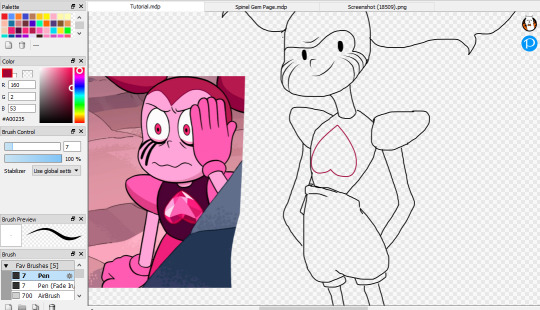
Step 3. Create a new layer and outline the gemstone with the outline colour you desire (as seen above)
From here on, I have a choice of two things – starting the layering process straight on this page, or switching to a new document to leave it clean. Whenever I draw a gemstone in PIC, I usually do the second option. Gemstones can take up many layers – Spinel, for instance, has eighteen facets and one outline, which would equal nineteen layers (unless I choose to do two facets per layer, giving me less, or adding shine effects, giving me more). This raises the counter for layers per page, which makes my laptop super slow when I eventually export the page. So this is my solution –

THE GEMSTONE PAGE!!!
As you can see, most of the gemstones I’ve drawn over the past few months are of Spinel. Two of them are of Steven’s gem as well. I’m sure a lot of these gemstones will look familiar, as most of them are ones I’ve used in PIC. Others do include my friend’s gemsonas/ocs, gemstones for ref sheets, or gemstones for pages of PIC that have not been released yet! ^^
But anyways, back to the tutorial –
Step 4. Copy the gemstone outline from the drawing, paste it to the Gemstone Page and move it to a free space.
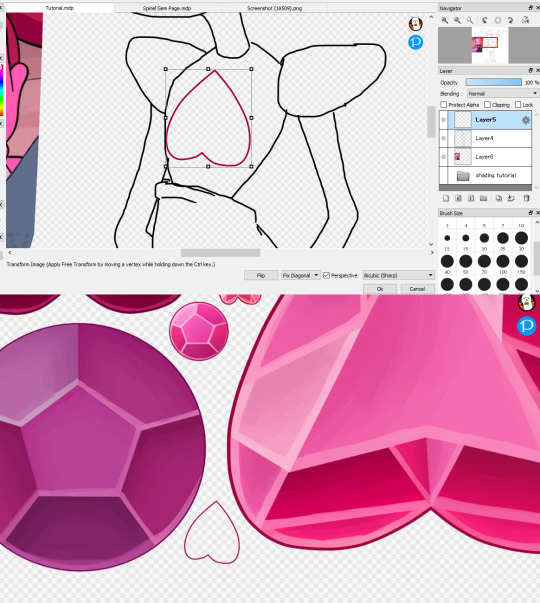
Here looks good!
Step 5. Start the facets!!!! I always begin with the biggest facet first. (Oh yeah, it’s a good idea to move the ref picture here as well XD)
The way I do it is by outlining it first, and then filling it in with the fill brush. Then I clean it up and crop it to how I want it to look!

And there, first facet is done with base colour!
Here comes the fun part. THE REST OF THE GEM!
I usually go top-down in a clockwise direction, but it literally doesn’t matter which way you go. (KEEP IN MIND ALL THESE FACETS ARE ON DIFFERENT LAYERS!!)
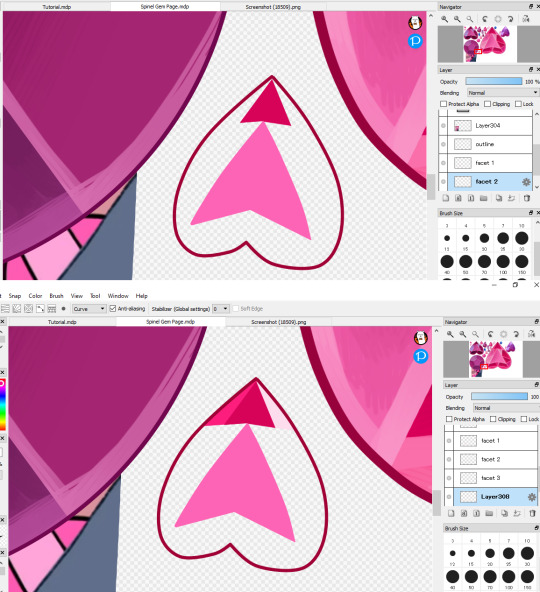
Four done!!!
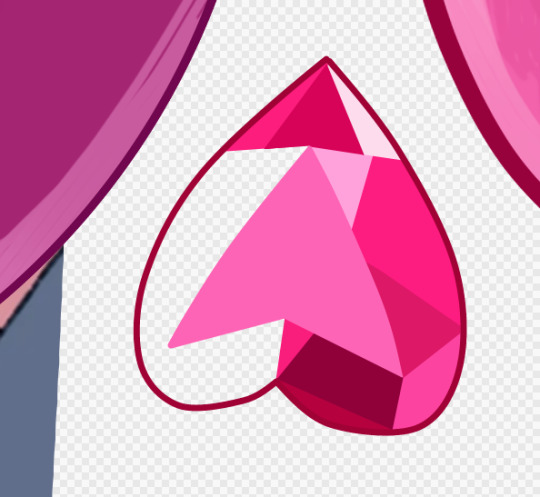
Halfway there!!!

DONE!! Base colour facets are complete!! (And exactly nineteen layers all up!!!)
Now it looks as good as a gem from the show! If you’re happy with this, this is a good yet optional place to stop. Since the next part is just as long as this, I’ve decided to split it into two tutorials (two-torials?) and the second one will include my way of shading!!!
Regardless, for now, I hope this helps some people!!!
(NOTE: Below is what the gem commonly looks like if you remove the top layer. All the imperfections are what makes it perfect!! The top layer covers these up, after all :D)
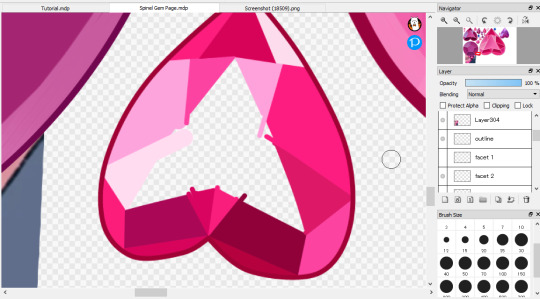
★。・:* Hyperlinks to Jinxy’s Other Tutorials *:・。★
Gemstone shading Character shading (IN PROGRESS) Backgrounds (heck this one will take a while)
#Partners In Crime#not partners in crime#tutorial#drawing tips#digital art#firealpaca#gemstone#how to draw#drawing tutorial#spinel#spinel steven universe
71 notes
·
View notes
Text
The GROW Coaching Goal Setting Model
New Post has been published on https://personalcoachingcenter.com/the-grow-coaching-goal-setting-model/
The GROW Coaching Goal Setting Model
The GROW model (or process) is a simple method for goal setting and problem solving. It was developed in the United Kingdom and has been used extensively in corporate coaching from the late 1980s and 1990s.
Contents
1 Stages of GROW
1.1 Example
2 History
3 The GROW principle and the Inner Game
4 Limitations
5 See also
6 Notes
7 References
8 Further reading
Stages of GROW
There are a number of different versions of the GROW model.[1] The following table presents one view of the stages but there are others.[1] The “O” in this version has two meanings.
As with many simple principles, any user of GROW can apply a great deal of skill and knowledge at each stage but the basic process remains as written above. There are numerous questions which the coach could use at any point and part of the skill of the coach is to know which questions to use and how much detail to uncover.[2]
Example
The following is a very simple example of using the GROW model to achieve a goal. This example deals with weight loss. If the client wants: “To bring my weight down to 120 pounds in three months and keep it down”, that is their Goal. The more heartfelt and personal, the more meaningful the goal is to the person and the more likely they will be to commit to and achieve the goal.
The GROW approach would then be to establish the Reality by stating what their weight is now. The coach would then ask awareness questions to deepen understanding of what is happening when the client tries to lose weight, thus identifying the Obstacles. These questions could include:
When you have been able to lose weight—what made the difference?
What is the difference between the times you are able to keep weight off and the times when you put it on again?
What would have to change for you to be sure you could lose the weight and keep it off?
If the client genuinely answers these questions they will discover new information about what works and does not work for them in terms of weight loss, and create some potential for change. It then becomes possible to create some strategies or Options which get around the Obstacles. These could include looking at which diets or exercise regimes work best, or finding a specific type of support. Once the client knows the strategies that are likely to work they can establish a Way Forward which involves taking action steps. This is where they commit to what they will do in the short term to put the strategies into effect. For instance, one action might be asking a particular person for support, and another might be to buy a different selection of foods.
GROW neatly highlights the nature of a problem for coaching purposes. In order for a problem to exist in coaching terms there has to be two elements present. Firstly there has to be something that the client is trying to achieve—the Goal. Then there has to be something stopping them achieve that goal—the Obstacle(s). Using GROW automatically breaks a problem down into these component parts.
The same principles can be applied whatever goal or problem the client has. GROW can be used on technical problems, issues regarding processes, strategy questions, interpersonal issues and many more. The model can also be used by a group who are all working on the same problem or goal.
History
In a 2009 article,[3] John Whitmore claimed that Max Landsberg coined the name GROW during a conversation with Graham Alexander and that Whitmore was the first to publish it in the 1992 first edition of his book Coaching for Performance.[4] Landsberg also published it a few years later in the 1996 first edition of his book The Tao of Coaching.[5] Elsewhere Whitmore said that the model had been in use for some time before it was given the name GROW.[6] Alan Fine’s 2010 book You Already Know How to Be Great claimed that Fine had codeveloped the model with Whitmore and Alexander.[7] Other (later) similar models include collaborative helping maps in family therapy[8] and Gabriele Oettingen’s WOOP model.[9]
The GROW principle and the Inner Game
GROW was influenced by the Inner Game method developed by Timothy Gallwey.[10] Gallwey was a tennis coach who noticed that he could often see what players were doing incorrectly but that simply telling them what they should be doing did not bring about lasting change.
The parallel between Gallwey’s Inner Game method and the GROW method can be illustrated by the example of players who do not keep their eyes on the ball. Some coaches might give instructions such as: “Keep your eye on the ball” to try to correct this. The problem with this sort of instruction is that a player will be able to follow it for a short while but may be unable to keep it in mind in the long term. So one day, instead of giving an instruction, Gallwey asked players to say “bounce” out loud when the ball bounced and “hit” out loud when they hit the ball.
The result was that the players started to improve without a lot of effort because they were keeping their eyes on the ball. But because of the way the instruction was given they did not have a voice in their heads saying “I must keep my eye on the ball.” Instead they were playing a simple game while they were playing tennis. Once Gallwey saw how play could be improved in this way, he stopped giving instructions and started asking questions that would help players discover for themselves what worked and what needed to change.
The GROW method is similar. For example, the first stage in the learning process would be to set a target which a player wants to achieve. If a player wanted to improve their first serve Gallwey would ask how many first serves out of ten they would like to get in. This is the Goal. The Reality would be defined by asking the player to serve 10 balls and seeing how many first serves went in.
Gallwey would then ask awareness-raising questions such as “What do you notice you are doing differently when the ball goes in or out?” This question would enable players to discover for themselves what was changing about their mind and body when the serve went in or out. They had then defined their Obstacles and Options. They therefore learned for themselves what had to change in order to meet their serving targets and they had a clear Way Forward.
The originators of both the Inner Game method and the GROW method suggested that many individuals were struggling to achieve goals because they were not learning from experience and were not aware of the available knowledge that would help them.
Limitations
Jonathan Passmore and Stefan Cantore suggested in 2012 that one “argument against behavioural-based approaches such as GROW is that their goal nature excludes the potential to explore philosophical aspects of life. Thus GROW may be suited to working in goal-directed areas of sports or business, but may be less well suited to careers conversations, person–role fit or life-coaching conversations where other approaches such as the transpersonal or existential approaches may be more helpful.”[11] See also Whitmore, Kauffman & David (2013) for a response to this criticism suggesting that GROW has evolved to include transpersonal goals.
See also
Decision cycle – other models of decision making
Decisional balance sheet – a matrix showing the costs and benefits of different options
Decision-making § GOFER – a model for teaching decision-making to adolescents
Immunity to change – a method of analyzing and overcoming psychological obstacles to goals
SMART criteria – criteria for composing goals
SOAP note – a tool for documenting a patient’s progress in the health professions
Transtheoretical model – another model of intentional change
Notes
^ a b c Published versions of GROW include, for example: Goal, Reality, Options, Wrap-up (Masciarelli 2000, p. 135, Landsberg 2003, pp. 30–31); Goal, Reality, Options, Wrap-up/Way forward (Alexander 2010, pp. 83–86); Goal oriented, Reality, Options, Way forward (Stamatis 2001, p. 85); Goal, Reality, Options, Way forward (Scales 2008, pp. 144–145, Fine & Merrill 2010); Goal setting, Reality, Obstacles and Options, Way forward (Griffiths & Kaday 2004, pp. 19–27, Bennett & Bush 2013, pp. 65–66); Goals, Reality, Options, Will (Whitmore, Kauffman & David 2013, p. 245, Gorell 2013, pp. 74–76); Goal, Reality, Options, Will to act (Parsloe & Wray 2000, pp. 67–68); Goal setting, Reality checking, Options, What is to be done & When & by Whom & the Will to do it (Whitmore 2009a, p. 55)
^ Questions that can be used at each stage can be found in a number of texts, for example: Landsberg 2003, pp. 108–109; Whitmore 2009a, pp. 58–92; Fine & Merrill 2010, pp. 60–61; Grant 2011, p. 120; McCarthy 2014
^ Whitmore 2009b
^ Whitmore 2009a
^ Landsberg 2003
^ Whitmore, Kauffman & David 2013
^ Fine & Merrill 2010
^ Madson 2011
^ Oettingen 2014
^ Parsloe & Wray 2000, p. 67: “The GROW technique has its origins in sports coaches who have been influenced by Tim Gallwey’s book The Inner Game of Tennis (1974). The technique relies heavily on using skilful questions and following a clear structure.”
^ Passmore & Cantore 2012, p. 22
References
Alexander, Graham (2010) [2006]. “Behavioural coaching—the GROW model”. In Passmore, Jonathan (ed.). Excellence in coaching: the industry guide (2nd ed.). London; Philadelphia: Kogan Page. pp. 83–93. ISBN 9780749456672. OCLC 521754202.CS1 maint: ref=harv (link).mw-parser-output cite.citationfont-style:inherit.mw-parser-output .citation qquotes:”””””””‘””‘”.mw-parser-output .id-lock-free a,.mw-parser-output .citation .cs1-lock-free abackground:linear-gradient(transparent,transparent),url(“//upload.wikimedia.org/wikipedia/commons/6/65/Lock-green.svg”)right 0.1em center/9px no-repeat.mw-parser-output .id-lock-limited a,.mw-parser-output .id-lock-registration a,.mw-parser-output .citation .cs1-lock-limited a,.mw-parser-output .citation .cs1-lock-registration abackground:linear-gradient(transparent,transparent),url(“//upload.wikimedia.org/wikipedia/commons/d/d6/Lock-gray-alt-2.svg”)right 0.1em center/9px no-repeat.mw-parser-output .id-lock-subscription a,.mw-parser-output .citation .cs1-lock-subscription abackground:linear-gradient(transparent,transparent),url(“//upload.wikimedia.org/wikipedia/commons/a/aa/Lock-red-alt-2.svg”)right 0.1em center/9px no-repeat.mw-parser-output .cs1-subscription,.mw-parser-output .cs1-registrationcolor:#555.mw-parser-output .cs1-subscription span,.mw-parser-output .cs1-registration spanborder-bottom:1px dotted;cursor:help.mw-parser-output .cs1-ws-icon abackground:linear-gradient(transparent,transparent),url(“//upload.wikimedia.org/wikipedia/commons/4/4c/Wikisource-logo.svg”)right 0.1em center/12px no-repeat.mw-parser-output code.cs1-codecolor:inherit;background:inherit;border:none;padding:inherit.mw-parser-output .cs1-hidden-errordisplay:none;font-size:100%.mw-parser-output .cs1-visible-errorfont-size:100%.mw-parser-output .cs1-maintdisplay:none;color:#33aa33;margin-left:0.3em.mw-parser-output .cs1-subscription,.mw-parser-output .cs1-registration,.mw-parser-output .cs1-formatfont-size:95%.mw-parser-output .cs1-kern-left,.mw-parser-output .cs1-kern-wl-leftpadding-left:0.2em.mw-parser-output .cs1-kern-right,.mw-parser-output .cs1-kern-wl-rightpadding-right:0.2em.mw-parser-output .citation .mw-selflinkfont-weight:inherit
Bennett, John L.; Bush, Mary Wayne (2013). Coaching for change. New York: Routledge. doi:10.4324/9780203140970. ISBN 9780415897815. OCLC 758394652.CS1 maint: ref=harv (link)
Fine, Alan; Merrill, Rebecca R. (2010). You already know how to be great: a simple way to remove interference and unlock your greatest potential. New York: Portfolio Penguin. ISBN 9781591843559. OCLC 555648015.CS1 maint: ref=harv (link)
Gorell, Ro (2013). “GROW as a process”. Group coaching: a practical guide to optimising collective talent in any organization. London; Philadelphia: Kogan Page. pp. 74–75. ISBN 9780749467593. OCLC 817579553.CS1 maint: ref=harv (link)
Grant, Anthony M. (December 2011). “Is it time to REGROW the GROW model? Issues related to teaching coaching session structures”. The Coaching Psychologist. 7 (2): 118–126. CiteSeerX 10.1.1.453.6410.CS1 maint: ref=harv (link)
Griffiths, Bob; Kaday, Chris (2004). Grow your own carrot: motivate yourself to success. London: Hodder and Stoughton. ISBN 9780340862858. OCLC 60960499.CS1 maint: ref=harv (link)
Landsberg, Max (2003) [1996]. The tao of coaching: boost your effectiveness at work by inspiring and developing those around you. London: Profile Books. ISBN 9781861976505. OCLC 223636717.CS1 maint: ref=harv (link)
Madson, William C. (December 2011). “Collaborative helping maps: a tool to guide thinking and action in family-centered services” (PDF). Family Process. 50 (4): 529–543. doi:10.1111/j.1545-5300.2011.01369.x. PMID 22145724.CS1 maint: ref=harv (link)
Masciarelli, James P. (2000). “The coaching moment”. PowerSkills: building top-level relationships for bottom-line results. Gloucester, MA: Nimbus Press. pp. 134–135. ISBN 9780967711119. OCLC 45136779.CS1 maint: ref=harv (link)
McCarthy, Dan (May 2014). “70 awesome coaching questions using the GROW model”. About.com. Retrieved 14 September 2014.CS1 maint: ref=harv (link)
Oettingen, Gabriele (2014). “The magic of WOOP”. Rethinking positive thinking: inside the new science of motivation. New York: Current. pp. 118–140. ISBN 9781591846871. OCLC 881498635.CS1 maint: ref=harv (link)
Parsloe, Eric; Wray, Monika Jamieson (2000). Coaching and mentoring: practical methods to improve learning. London: Kogan Page. ISBN 9780749431181. OCLC 44058686.CS1 maint: ref=harv (link)
Passmore, Jonathan; Cantore, Stefan (2012). “Helping others to set goals: the GROW model”. Top business psychology models: 50 transforming ideas for leaders, consultants, and coaches. London; Philadelphia: Kogan Page. pp. 20–23. ISBN 9780749464653. OCLC 779740299.CS1 maint: ref=harv (link)
Scales, Peter (2008). Teaching in the lifelong learning sector. Maidenhead; New York: McGraw-Hill/Open University Press. ISBN 9780335222391. OCLC 179805428.CS1 maint: ref=harv (link)
Stamatis, D. H. (2001). Six sigma and beyond: foundations of excellent performance. 1. Boca Raton, FL: St. Lucie Press. ISBN 1574443119. OCLC 47100858.CS1 maint: ref=harv (link)
Whitmore, John (2009a) [1992]. Coaching for performance: GROWing human potential and purpose: the principles and practice of coaching and leadership. People skills for professionals (4th ed.). Boston: Nicholas Brealey. ISBN 9781857885354. OCLC 314840903.CS1 maint: ref=harv (link) The 5th edition was published in 2017: ISBN 9781473658127. OCLC 1004819121.
Whitmore, John (2009b). “The impact of the Inner Game and Sir John Whitmore on coaching: a commentary” (PDF). Annual Review of High Performance Coaching and Consulting. 4 (2 Suppl): 23–28. doi:10.1260/ijssc.4.suppl-2.671q532j757771rl. Archived from the original (PDF) on 2019-07-22.CS1 maint: ref=harv (link)
Whitmore, John; Kauffman, Carol; David, Susan A. (2013). “GROW grows up: from winning the game to pursuing transpersonal goals”. In David, Susan A.; Clutterbuck, David; Megginson, David (eds.). Beyond goals: effective strategies for coaching and mentoring. Farnham, Surrey: Gower Publishing Limited. pp. 245–260. doi:10.4324/9781315569208. ISBN 9781409418511. OCLC 828416668.CS1 maint: ref=harv (link)
Further reading
Brown, Saul W.; Grant, Anthony M. (March 2010). “From GROW to GROUP: theoretical issues and a practical model for group coaching in organisations”. Coaching: An International Journal of Theory, Research & Practice. 3 (1): 30–45. doi:10.1080/17521880903559697.CS1 maint: ref=harv (link)
Dexter, Janice; Dexter, Graham; Irving, Judy (2011). “GROW model”. An introduction to coaching. London; Los Angeles: Sage Publications. pp. 28–30. doi:10.4135/9781446251867.n3. ISBN 9781849202985. OCLC 678881616.CS1 maint: ref=harv (link)
Eldridge, Fiona; Dembkowski, Sabine (2013). “Behavioral coaching”. In Passmore, Jonathan; Peterson, David B.; Freire, Tereza (eds.). The Wiley-Blackwell handbook of the psychology of coaching and mentoring. Wiley-Blackwell handbooks in organizational psychology. Hoboken, NJ: John Wiley & Sons. pp. 298–318. doi:10.1002/9781118326459.ch16. ISBN 9781119993155. OCLC 796758879.CS1 maint: ref=harv (link)
Grant, Anthony M. (September 2012). “An integrated model of goal-focused coaching: an evidence-based framework for teaching and practice”. International Coaching Psychology Review. 7 (2): 146–165.CS1 maint: ref=harv (link)
Ives, Yossi; Cox, Elaine (2012). Goal-focused coaching: theory and practice. New York: Routledge. doi:10.4324/9780203131640. ISBN 9780415808958. OCLC 741542041.CS1 maint: ref=harv (link)
Kegan, Robert; Congleton, Christina; David, Susan A. (2013). “The goals behind the goals: pursuing adult development in the coaching enterprise”. In David, Susan A.; Clutterbuck, David; Megginson, David (eds.). Beyond goals: effective strategies for coaching and mentoring. Farnham, Surrey: Gower Publishing Limited. pp. 229–244. doi:10.4324/9781315569208. ISBN 9781409418511. OCLC 828416668.CS1 maint: ref=harv (link)
Law, Ho (2013). “GROW model and universal integrative framework: build your own model and apply it”. Coaching psychology: a practitioners guide. Hoboken, NJ: John Wiley & Sons. pp. 77–98. doi:10.1002/9781118598399.ch6. ISBN 9781119954675.CS1 maint: ref=harv (link)
Wilson, Carol (2011). “Solution-focused coaching and the GROW model”. In Wildflower, Leni; Brennan, Diane (eds.). The handbook of knowledge-based coaching: from theory to practice. San Francisco: Jossey-Bass. pp. 279–285. ISBN 9780470624449. OCLC 694394200.CS1 maint: ref=harv (link)
Source: https://en.wikipedia.org/wiki/GROW_model
#best personal development coaching#business coaching#coaching#coaching (profession)#coaching and the grow model#coaching demonstration#coaching model#Coaching Tips#executive coaching#goal setting#grow coaching#grow coaching model#grow coaching model explained#grow model#grow model coaching#grow model coaching conversation#grow model coaching examples#grow model coaching questions#grow model for coaching#grow model of coaching#how to start personal branding#how to use grow model in coaching sessions#leadership coaching#life coach#life coach for women#life coaching#life coaching 101#life coaching questions#life coaching session#life coaching techniques
0 notes
Text
Emerging Practices - New Analysis
Previously I analysed the 2013 version of Google Glass as this was suggested in week one. After learning more in the sessions after the first lesson I found it harder to properly analyse Google Glass as we had discussed it a lot in class and it is also six years old.
As a result I’ve decided to instead find a new technology to analyse and after looking at a few projects such as a Walkman clone which has Bluetooth functionality and gives that ‘analog’ experience through a digital output I came across a travel item (or travel items I’m still not sure).
Travel Re-defined by the Frenchie Co.
After scrolling through the Design & Tech section of Kickstarter I found this - I was curious how a bag could compress so many clothes effectively as the photo was showing below after travelling to Europe last year for seven months with only carry on luggage.
Watch the video here:
https://www.kickstarter.com/projects/the-frenchie-co/travel-gear-that-seems-from-the-future?ref=section-design-tech-projectcollection-staff-picks-category-newest

I clicked on the link and was taken to the main page. Starting with the video I was greeted by -

With only this?

After travelling I know how important it is to pack light and this ‘Instagram influencer’ style intro makes me excited to see how their backpack advertised is going to ‘re define’ travel. If I could pack for 30 days with only one spare pair of pants, two shirts and two pairs of undies - along with an unnecessary laptop and camera for people packing light which adds greatly to the aesthetic.
The solution -

Turns out 10 seconds into the video that I was greatly wrong about the bag changing my life - or was I? Find out later in the video after watching it a few times I’m still not sure myself.
I now see that they were not selling a small bag but instead ‘the ultimate travel clothing’ as much as I have not done as much in the last couple of years I used to be heavily involved with adventure sports throughout high school and I know my way around adventure and travel brands and I can recognize quality when I see it. If they can truly make it possible for me to travel with as few clothes as the aesthetic picture above then I’m all for it.


Oh yeah - Chemistry lab which is most likely stock footage I’m pumped
“The most advanced T-shirts and Jeans you’ve ever seen”

They claimed to have partnered with the University of Southampton to create a new fabric. This isn't explained technically much detail but this screenshot shows the example of an experiment.
The experiment reads -
“After 3 or 24 hours contact the bacteria were stained with fluorescent green dye. The stain binds to the intact DNA of live and intact dead cells. Loss of fluorescence suggests the cells are dying as the DNA breaks down”.
I have two questions -
1. What is the control fabric? - Is it cotton or simply a sheet of plastic which simply doesn’t absorb any liquid?
2. From what I read they are trying to claim that their fabric ‘kills’ cells faster than normal fabric. If dying cells are what make clothes stink then would you stink quicker in this fabric? - To be honest I am lost trying to understand the technical details at this point.
University of Southampton collaboration:
After searching keywords from the experiment shown below as well as searching “University of Southampton & the Frenchie Co. etc. I couldn’t find any proof of this partnership, this does not mean it doesn’t exist - but simply that if it does exist it is hard to find.
“This material outperforms Merino Wool and Silver by up to 53%”

Now what they are referring to is the wear time - they claim you can wear one of their T-shirts for up to 10 days. I assume that then means that a merino shirt can be worn ‘hygienically’ I assume for 4.7 days. As a hiker I can say that this is possible, and you can do this when restricted for weight however when travelling in cities as this seems it is aimed at I would highly recommend a fresh shirt every day. I see hiking and city based travelling as from my experience you do a similar amount of walking on each day.

I’m not sure if I’m personally keen on wearing the same shirt for ten days, even if it is made of a new technical material which allows that.
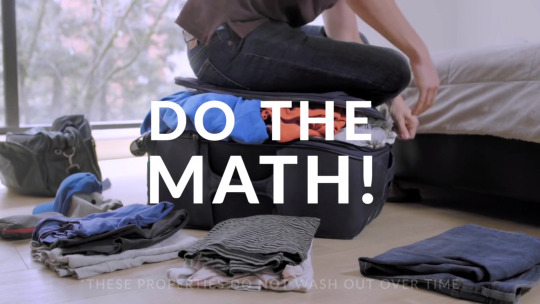
Not yet...

Not yet...

Not yet...

There it is.

They claim - “85% of the carbon footprint of clothing happens during laundry”
They challenge fast fashion by creating fast fashion. I understand that by not washing my clothes I am being more environmentally friendly, however some things are essential as a human being.
After selling themselves toward the market of a person who is travelling for 30 days, they then claim with 5 T-shirts you would only need to wash your clothes 7 times per year - I’m really not convinced I would want to wear the same shirt 10 days in a row all year round, however the technology behind it is interesting.
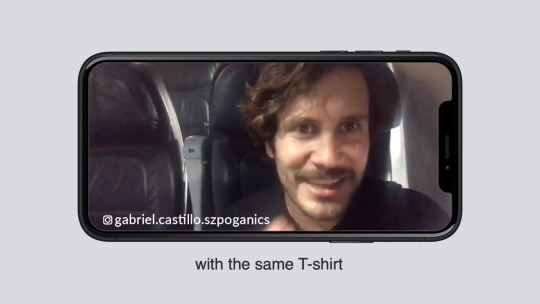
This guy creates a testimonial to say that he has been in the same shirt for over 40 days - even though they say it has no smell for up to 10. This makes me wonder if their target market are ‘those’ backpackers who for fill the stereotype of being unhygienic and if this guy could make the same video if he was wearing a T-Shirt by Kathmandu or The North Face regardless of its material.
I saw they had his Instagram handle, and he is some guy who likes to travel with 1,500 followers, despite them looking as if they had recorded an Influencer.
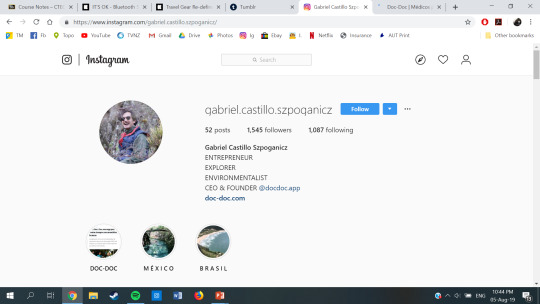
He also has no features of “the Frenchie Co. on his Instagram.

They claim that their clothing doesn’t require ironing - as most synthetics don’t then show the model wearing a suit jacket, however they only manufacture Jeans and T-shirts, so I would assume that to look that sharp you do need to iron the suit.

They are essentially making jeggings for men (which I like the idea of I was always jealous of my sister when she was 10 and had them. These are donned as the most comfortable Jeans you’ll ever own - due to the stretchiness. However, I have owned comfortable stretchy jeans before and they are not a new technology as these are being sold as.

Ironically, after me coming to be interested in this technology for way the bag could bring down the amount of clothes needed for a trip the same Kickstarter video as the clothes also features the backpack. Only, this backpack doesn’t help you shrink down clothes and the rolling technique still wins. They sell it as the “most engineered backpack in the market”, however I see it as over-engineering with its 29 pockets.
As with every backpack in the market it is rain resistant and has YKK zippers (a genuine sign of quality.) Other than the fact it has 29 pockets so even you couldn’t find your things I’m not sure how it is ‘anti theft’ any better than me using my combination lock on the zips of my Kathmandu day backpack I’ve used in questionable areas of Europe.
0 notes
Text
Nice to Party You ☆ It's Tomita Suzuka YO!
Member: Tomita Suzuka Source: 2nd gen Hiragana Keyakizaka46 blog Post date: 2017/12/04 20:37
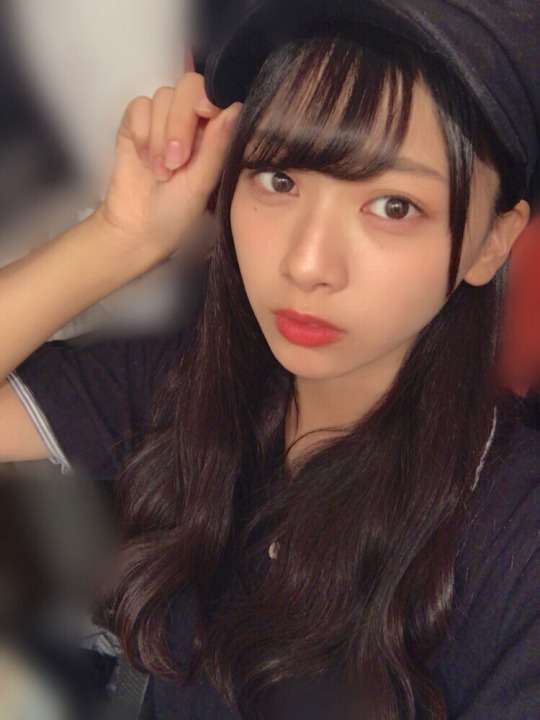

I've been a party-goer since before I was born! I've come here as a newbie, and every day is full of discoveries (´∇`) Let me once again introduce myself. I'm Tomita Suzuka, a second generation Hiragana Keyakizaka46 member. Nice to meet you~~~~~!! Nice to party you~~!! 1 I'm a 16 year old, second year high schooler from Kanagawa prefecture. The second generation members' blog has started! I'm very happy!! I've wished for a place that would let me quickly connect with everyone. And I've finally, finally gotten it! Haa, haa... I'm really so happy ( ˃̣̣̥ω˂̣̣̥ ) Tears are welling up. I'm pretty sure fans are expecting Paripi-chan2 to have a party-like blog but... From here on out, I'll leave Paripi-chan behind and write as Diligent-chan3. Please stay put and don't close the page!! If I ever started a blog, I told myself I'd definitely post this picture ( ´﹀` ) What do you think? I think this is a good picture of myself. In fact, it's so good that I seriously consider it the best picture that I've seen of myself, in my whole entire life. So good that I should be charging money for it (^^) j/k (^^) I wonder how everyone sees this picture? (lol)
The food family (Matsuda Konoka & Watanabe Miho) are attacking Hina (Kawata Hina) (∩´﹏`∩) During lessons or in the dressing room, there's always something frivolous like this happening (lol)


Well, well, 2017 will end in about a month. Somehow, that went by quickly... Especially since the month of August! During the summer break, without doing my homework, I struggled hard and risked my life for the SHOWROOM auditions. Actually, on the last day of the SHOWROOM auditions, I made a very important promise with my best friend. At that time, it's because my best friend told me "Let's stop this tomorrow!" that I'm able to be here right now. Starting at 5:46AM, I did an early morning broadcast and my Mom made sure to take the dog out for a walk at that time. I'm sure that my dog was happy about getting an early walk too (U「・ω・)「 I'm grateful for all the support that my best friend, my mother and my family gave me. I've been watching all of the recommendation comments that I received from people after the SHOWROOM broadcasts ended! I've properly remembered them!! I want to quickly meet with all of you (^^) At that time, I had decided to do the broadcasts without showing myself. I took that decision fully aware that doing broadcasts without showing my face would put me at a disadvantage compared to the girls who would show themselves. Because I didn't show myself, all I had at my disposal was my talking skill. Since people would only be able enjoy my broadcasts through their ears, I put a lot of thought every day into what I was going to do. For example, I played "Overture" on the guitar. On the last day, I had recorded the accompaniment in advance, and played the melody live during the broadcast! I came up with things that I thought the other girls would definitely not do! To tell the truth, I personally thought that what I showed was too good! When thinking of what I did, I was conceited and thought "Ah~ That was awesome!" ( ̄▽ ̄) With each passing broadcast, I felt like I was getting better at talking! These broadcasts will become a source of encouragement for myself in the future, when I look back at them. They were a wonderful experience (^^) I think the people who listened to me from the beginning know this, but during the first broadcast, I tried to portray the "good girl" (lol). That was an impossible feat wasn't it...? With how I am now, I'm so embarrassed when I listen to that first broadcast (lol) This is the cheat sheet I put together right before the SHOWROOM broadcast. Since it was done in a hurry, my writing was sloppy, but as long as it could help me convey my thoughts, then that was good enough (˃̣̣̥ω˂̣̣̥ ) My Paripi-chan character is the result of all the people who watched my SHOWROOM broadcasts and helped me create that persona! I want to become an idol who considers "individuality" important~! It's been about three and a half months since I was chosen to become an additional member of Hiragana Keyaki. I still haven't come to grip with that fact yet (´•ω•̥`) There are instants where I tell myself "Ah, I'm an idol now." I'd like to challenge myself with singing, dancing, appearing on variety shows and the various other things that I will be faced with! Even if I can't get you to like me, I'm happy just knowing that you are aware of me! At first, you might dislike me, but you'll gradually grow to like me. I think that it's the same thing as with food (^^) [So she's something like an acquired taste?] Back then, I disliked yogurt (^^) But now, I love it! I want to become someone who people rapidly get hooked to, after having gotten to experience me time after time. [Does this mean she wants us to consider her like a drug? ww] I guess I'll make this my favorite motto: "someone who's taste becomes more apparent the more you chew on"...4 I'll become a human gum. [Uh, what? w] That's why no matter what your impression of me is, Paripi-chan will give it her all so that you remember me even just a little bit ⊂( *・ω・ )⊃ And also, I'd be glad if you could give me your support and encouragement. Thank you for reading my first blog! It ended up being long! [No kidding... This is by far the longest 2nd gen Hiragana member blog up to date!] Well then, it'll be from Diligent-chan back to Paripi-chan (lol) I think this is the first time for everyone, but please forgive me for my split personality with Paripi and Diligent m(_ _)m Tomorrow, it'll be Nibu Akari, also known as Nibubu!☆ Well then, that's a wrap! This was Paripi-Juju-Nobuko-Suzuppi! Pari Peace ('ω')v P.S. I wonder if there are many people who want know the origins of the nickname "Nobuko" ( ´﹀` ) Which nickname should I use?
This was a... difficult blog to translate. I had a hard time following Paripi's train of thought at some points in her blog post. So I'm not sure this translation properly conveys what she wrote, as there are subtleties that I feel went right above my head. There are some parts where she seems conceited and brags about herself, which I don't often see in idol blogs... I hope I'm just misunderstanding something w
Also, the amount of white space that Paripi uses was even more pronounced than Kosako Nao orz...
She makes a pun on "hajimemashite" and writes "parimemashite." ↩︎
Tomita Suzuka's nickname is "Paripi", which an abbreviation of "party people" and is used to refer to a party-goer or a clubber. ↩︎
She refers to herself as "Majime-chan." Majime (真面目) means diligent/serious/honest. ↩︎
The expression in Japanese is 「噛めば噛むほど味が出る人間」. ↩︎
0 notes
Photo


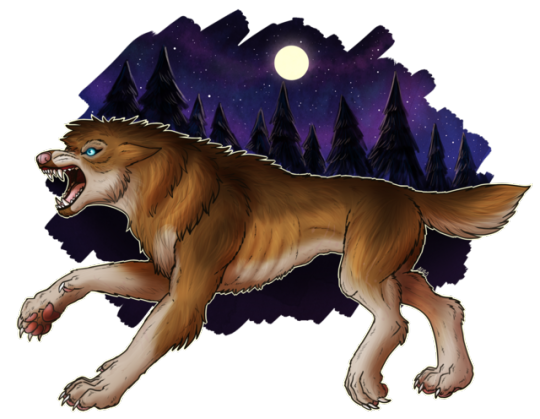

Here’s a werewolf TF comic page proposal.
I hope its not TOO tacky to include your own art you did for yourself as refs but It thought it would be better to make this post pretty much a one stop package deal for everything because I don’t even know where you may have those I designed this so that later on, I could theoretically add more pages before or after this page in the future and eventually build a full comic out of it.
The scene would loosely be like the photo I included, but set at night. It can be dark with moon be moonlight coming in through the window and WITHOUT the blinds as that would further complicate the lighting.
It shouldn’t be exactly that scene, but I just wanted to establish the sort of scene based on my bedroom, mostly the paint of the room the backboard of the bed, dont worry about the posters or anything, and you can position the camera closer to him or at a slightly different angle, just whatever you need to show H from the navel level up to his head laying on the pillow.
I figured H pulled the sheets off his bed.
A shirtless is laying on a bed with his head on the pillows, unlike my other TF’s this is more traditional in the sense that this is actually painful and H is having a bad time, and there can be tears rolling down his face maybe. lets say he’s a character in a horror movie or something.
H is in the middle of transforming into a quadruped werewolf of similar shape and design as you gave to Myra in that “Julycanthropy” pic you did of her. His upper body from the navel up is fully transformed and furred (with brown fur) into a deep, broad, bestial shape with the shape of the ribs visible beneath the skin.
His face is still human (no muzzle) except that he has dark brown animal eyes, and large canine ears which are still unfurred, similar to halffox H’s ears, poking out from under his locs.
It gives the impression that his entire body has changed into a monsters but his head, face, arms, and hands are still trying to cling to their humanity.
In panel one, his hands start as being almost entirely human, but have clearly elongated a couple of inches between the wrist and where the fingers begin, but still with normal human looking fingers, nails, and palms.
The second panel has a “sweep” with a close up detail of his hands as they go to as being described above to being bestial paws clearly designed for standing running on all fours, with well developed (black) pawpads and black claws. PAGE ?? Panel 1 – A close up view from the navel up, H lays back on the pillows but not comfortably, in his extreme pain and physical exhaustion he’s too exhausted and weary to rise from bed, and all he can do is look down at his rapidly transforming body.
His chest and upper body is 100% transformed, given the impression of a nearly human head and arms attached the body of a huge, monstrous, furred beast.
His eyes are fully transformed and resemble the yellow eyes of that wolf you showed me a pictue of as reference (his fur is also the color of the wolf from that photo)
His ears are transforming and have grown the shape of fox-H’s ears from the piece posted above where he’s on all fours, but in this panel his ears are sticking out from beneath his hair, but are only about half the size as fox-H’s ears are in the afformentioned piece.
He raises his hands looking upon them as the begin to transform. One hand is still 100% normal and human, but the other has obviously elongated by two inches between his wrist and the end of his palm before the fingers, but still has normal fingers and palm. His hands and arms are unfurred. ****
Panel 2 – Four “frame” sweep with a simple BG, with a close up detail of H’s hands as they change, getting multiple angles as the change takes place:
A. Both of H’s hands are transformed to the level described in the first panel B. Both hands further elongate, and grow broader and “thicker”, with stubbier fingers, claws, and pawpads beginning to develop, along with a small amount of fur. C. H’s hands have morphed to a state resembling Myras in that sketch you did on Tumblr months back, clearly overwhelming paw like with fur having grown in significantly and spreading. D. H’s hands are fully developed and have properly transformed with the fur grown in, with the thumbs having become dewclaws, these things are like 95% like an actual wolf’s forepaws but have that slight humanlike residual element you like to give your werewolf’s forelimbs.
****
Panel 3 – (you can do a low detail “mini panel” if you need to in order to make this fit on the page) H, close up face, which is unfurred as before, but now with a wet “doggie nose to go with the ears (he still has no muzzle or snout yet) looks upon his transformed hands with horror, his forelimbs are fully furred up to his elbows, if those even make it into the frame.
His ears have grown 55% from the previous panel and are about 5% larger than H’s ears are in the half-fox H piece.
0 notes